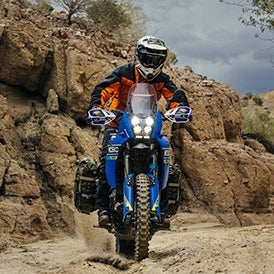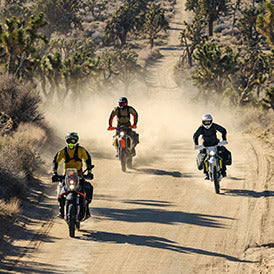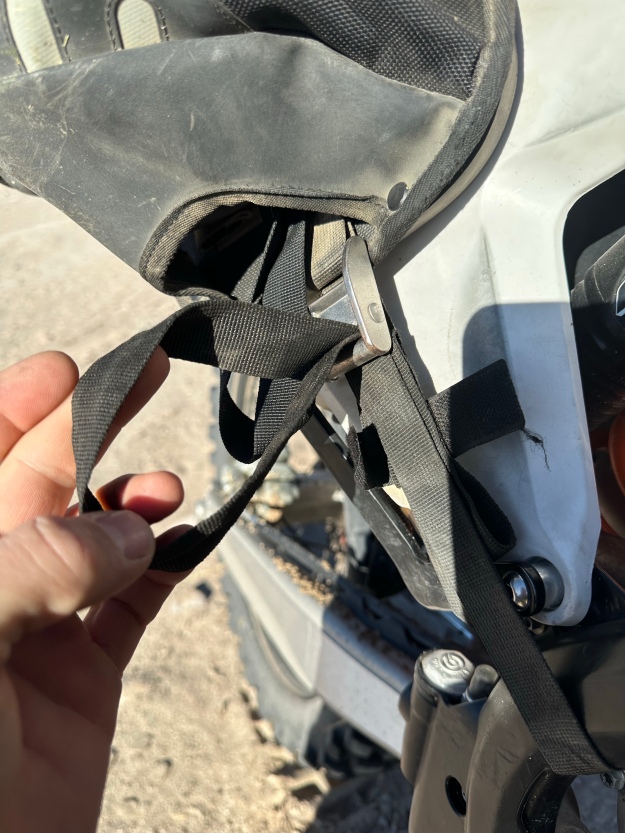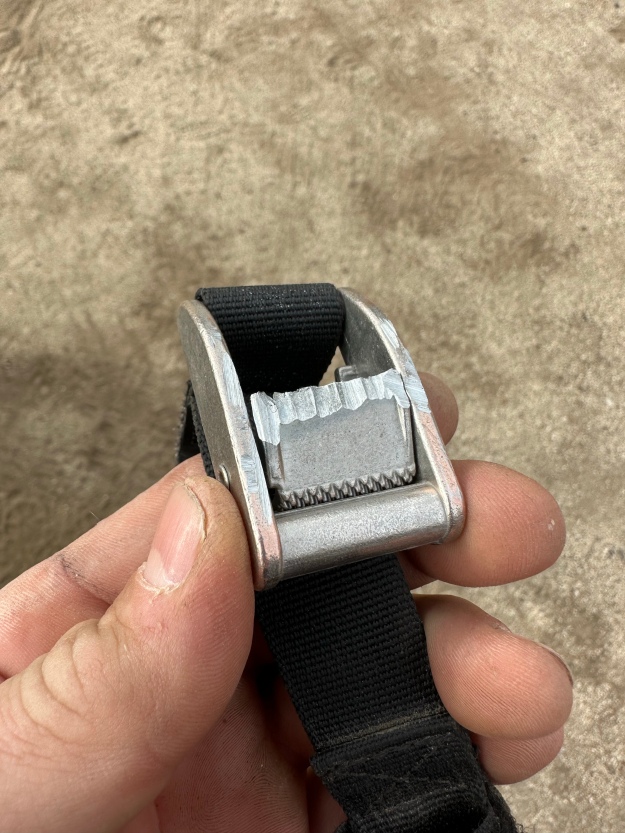Your Cart is Empty
Free Shipping On Orders Over €200
Luggage
Apparel
The Mosko Blog
Happy New Year from Ushuaia!
February 28, 2023
Happy New Year from Ushuaia!
February 22, 2023
I started writing this on a flight to Chile, updated it at hotels/campsites as I rode south (changing this sentence every time), and now I’m actually finishing and posting it from my phone in Ushuaia 3.5 weeks later. The trip’s nearly over now, just a few days of riding left, but if you’re interested in seeing some clips from the journey, they’re posted in the story highlight labeled ‘Patagonia’ on my personal Instagram (@moskopete).
Patagonia and Ushuaia are famous ADV destinations, and now that I’m here I can see why. The distances are big, the riding is approachable, the weather is dramatic, the people are friendly, and the landscapes are out of this world. Plus there’s the unique geographic achievement of reaching the pointy tip of a major continent. I’m glad to have a full size adventure bike here with a tall front windscreen. The 150-250cc dualsports I normally get on international trips would be tough here, with the long distances and powerful sidewinds (40-50 mph). Not that you couldn’t do it, it would just be tough.
Since the last post, we wrapped up 2022 and we’re happy to have it behind us. It was a decent year for sales, but margins suffered because of the summer sale and the supply chain problems that dogged us all year. Plus the cost of everything went up, and the strong dollar made Mosko products more expensive overseas. Looking back, I’m happy with the outcome and how we navigated a very weird year, but also I’m happy it’s over.
If I could craft a perfect 2023 for Mosko, it would be a year of modest, manageable growth, product improvements, cost control, and stability. Just a good old fashioned normal business year. Design some cool products, fix some processes, show at the shows, keep our shelves stocked, and go on some awesome rides. That’s Mosko’s version of adulting. The last few years were a rollercoaster. A chill 2023 filled with basic blocking and tackling sounds great. Will the universe cooperate? Probably not 
 .
.
Patagonia Trip
Here are a couple packing videos from my garage before leaving for Chile.
This trip was perfect for testing the latest Mosko Mule prototype. The Mule is our new – massive – modular gear hauler. It’s actually two individual bags that connect, but you separate them at the check-in counter and check them individually. On this trip I brought all my own moto luggage for the rental bike, plus pannier racks, prototype mounts, and backup mounts in case there was an issue with the prototypes. That’s in addition to camping and riding gear, camera gear, tools, and all the rest. The Mule worked like a charm. I’m not sure how a single person could transport that much gear through airports and borders without it.
The reason for all that gear – besides the fact that there’s no way I’m riding around South America for a month with some random brand of hard luggage  – was so I could test a new mounting system for the Backcountry Panniers. It’s a solution for BMW OEM pannier racks that doesn’t require an adapter for the offset exhaust. We’re calling it the ‘Euro Mount.’ We’ve been tinkering with this for a while, and it’s already been tested on some shorter trips with the 1200/1250. Arriving in Chile I tried to mount it on the 850 I rented and immediately realized it wasn’t going to fit. I had to run out and buy an angle grinder to make some modifications. In a way, that discovery alone paid for the trip
– was so I could test a new mounting system for the Backcountry Panniers. It’s a solution for BMW OEM pannier racks that doesn’t require an adapter for the offset exhaust. We’re calling it the ‘Euro Mount.’ We’ve been tinkering with this for a while, and it’s already been tested on some shorter trips with the 1200/1250. Arriving in Chile I tried to mount it on the 850 I rented and immediately realized it wasn’t going to fit. I had to run out and buy an angle grinder to make some modifications. In a way, that discovery alone paid for the trip  Although I didn’t have to fly all the way to Chile just for that.
Although I didn’t have to fly all the way to Chile just for that.


In general: for an international fly-in trip with a Reckless 80 (not the bc35s I brought on this trip), my own tools, and camping gear, I figure it takes two bags at 50 pounds and 62 linear inches each, plus a couple smaller carry-ons. That’s the max they allow without overcharges. I always end up needing more volume than I expect. If I skipped the camping gear, cooking stuff, and tools I could save a lot of space & weight, but usually I want to take those things. Either way, my point is, the Mule is awesome for fly-in trips.
For apparel, I brought the new 2023 basilisk jacket/pants as my outer layer, and a workhorse jersey to wear over armor. It’s a lot of high speed riding here, on pavement and graded gravel, and I’ve had extremely variable weather ranging from high 90s and sunshine down to low 40s, rainy, and windy. Perfect weather for the Basilisk/workhorse combo.
Another key piece of my kit on this trip is the Ectotherm jacket. My time here would’ve been far less enjoyable without it. Most days I start early and end late, and several days have been cold and rainy from the start. The Ectotherm – layered over the Strata and Graph tops with the Strata hood tucked under my helmet – kept me warm throughout. It’s also been great off the bike too, being the only puffy I brought along. I love how the Ectotherm so naturally transitions between on-bike and off-bike use. That’s really one of my favorite things about it.
The rain was perfect for testing the new Basilisk kit. The jacket performed flawlessly. The pants have also done great, but I noticed at slow speeds in heavy rain, there was some pooling of water on the thigh vent zippers. I had to keep an eye on that as I rode. I applied some waxy zipper lube to make the zipper more water resistant, and I also emptied the pockets in rain, because I noticed that full thigh pockets made little channels where water could accumulate. In the next order we may reduce the size of the thigh vents. They’re awesome in hot weather, but venting and waterproofing work against each other. Venting involves cutting and expanding holes, waterproofing involves reducing and eliminating holes. Scottie pointed out recently, that after summer trips we all come back asking for more and bigger vents. Then we go on a cold/wet weather trip a few months later with the same garment, and suddenly everyone’s talking about getting rid of vents. 
The luggage I brought on this trip has all done great. No failures, no leaks. Even the new Euro Mount. The only issues I’ve had with the new mounts were the initial fitment problems, and a couple nuts coming loose, both easily fixed. I love traveling with the backcountry kit. It’s so bomber and so convenient, with stash spots everywhere.
Even if it’s been raining all day, I know with complete certainty that everything’s going to be totally dry when I stop for the night. I don’t even have to think about it. I love how easily the bags dismount and come into a tent or room with me, and how easily I can lock them up when I get on a ferry (lots of ferries here). The BC kit has come a long way since we first introduced it 10 years ago, and I’m super proud of where it stands today.
Same thing for the Nomax tank bag. On this trip I was testing a prototype of a new version of the Nomax that has an expansion zipper on the side, much more comfortable backpack straps, and more charging cable organizers inside, since nowadays we carry so many more things to charge. My cash, camera gear, passport, and bike documents live in the Nomax, so it goes wherever I go, on or off the bike. This new expandable version feels like a nice upgrade to the original. Now that we offer the smaller Gnome, it makes sense to increase the capacity of the Nomax slightly.
LOVE the new Nomax backpack straps. They are so much more comfortable than before. A little less stashable (because they’re more padded) but they’re also removable.
The whole way along this trip, I’ve been stopping to make product videos for Mosko, and capturing little clips for Instagram. I’m traveling solo, mostly keeping to myself, camping whenever I can, and skipping the larger towns and hostels. Pausing along the way to document the journey and talk about the products I’m using feels very natural. It adds a dynamic to solo travel that I really dig. It’s been neat to lean into that. I have 24 (!!) different Mosko products with me on this trip, including 7 new prototypes, so I’m not going to run out of things to talk about.
In a few days I’ll be returning home with enough raw video content to keep me busy with editing for a while. Here are some quick clips from making a video for the Strata long underwear kit a few nights ago. The cool thing about making product videos while traveling, is that nothing’s staged. It slows down the trip a little – which is why I prefer being solo – but it’s also a lot more fun (to me) than a professional shoot. I’m just documenting the things I’d be doing anyway, even if the camera wasn’t there.
Borrego Springs Trip
Over the holidays I spent a few weeks in the desert, riding and working on videos. The first stop was Borrego Springs, a few hours east of San Diego in the middle of Anza Borrego state park. I’ve wanted to check that area out for a while, and it was everything I’d hoped. There are tons of 4×4 tracks, many interesting natural features, and lots of big sandy washes to explore. Plus it’s just a few hours north of Baja, so it’s a great place to stage trips south of the border. In Borrego I alternated between my 1290 and 500, riding during the day and stopping along the way to make videos.
A highlight of that trip was testing the new Hood top bag Andrew’s been working on, with lots of input from Roel and the Europe team. I always viewed this style of bag as a ‘commuter’ bag, and never really paid much attention to them. But after riding with it for a few days I realized how myopic that was. It’s actually really handy to click it open and get access to the contents quickly, especially for my camera gear and drone. Plus it fits a helmet. I would definitely consider using this as a top bag on an extended trip, vs say a larger traditional dry bag duffle. And it would be great for day rides too. We’re still working out some challenges with respect to the bottom and the mounting system, but even this early version in its current state worked great. You can see it in the clips below.
In Borrego I got to spend some long desert days in the new Basilisk kit, using all the vents, especially the huge thigh vents on the pants. It’s crazy how much air those vents let in. The airflow on a hot day is seriously impressive. Then you can zip them shut and seal everything up when the temperature drops. Btw, I shot this on Christmas Day. 
Baja Trip
After Borrego, I headed south to Baja to meet up with some buddies. For this trip we took 450s/500s, and we were riding unsupported (ie no chase vehicle) and without camping gear. So we stayed in hotels and ranches instead of camping. That way we could keep the bikes light, and get off the ADV thoroughfares in search of more interesting terrain.
Our friend Justin Strong (IG: @bajaeveryday) recently opened an awesome new hotel/guesthouse/campground for the moto community just south of Mexicali called Baja Oasis (IG: @baja_oasis). Justin is a Baja pro and he helped us outline a route from east to west and back, starting and ending at Baja Oasis, with a mix of hot springs, hotels, singletrack, double track, ranchos, open sand, and bushwhacking. It was awesome.
For bags on this trip, I chose a Reckless 40 (a prototype of a new version) with no center bag, mounted with the new Gnobblin mount. I had some issues with my boots hitting the Reckless 40 cam buckles – a known issue on some bikes – and causing them to loosen up while riding. There’s a fix on the way for this: we’re making some custom cam buckles with a recessed lever, so it’s protected by the sidewalls of the buckle. In the meantime, here are a couple field repairs we developed on this trip.
1. The quick way: double up the webbing and run it through the cam buckle as a loop. This pushes the friction end of the cam lever up, which pushes the finger end of the cam buckle down, leaving it below the sidewalls of the buckle.
2. The permanent way: grind down the top of the cam lever with a table grinder. It’s messy but it’s permanent and it works. If you do this, we’ll be happy to swap out your buckles when we get the new ones in stock (might be a minute tho). This mod will not affect your warranty.
Both solutions held for the duration of the trip. On my 500 with the gnobblin mount on the back, the prototype harness, and the modified cam buckles, man it was connected so solid. Almost like part of the bike.
For apparel in Baja I chose the Rak jacket and Woodsman pants, and I brought our old Deluge rain pants as an overlayer. At the moment we don’t have a replacement for the Deluge yet, which is a major blank spot in our line. Soon we’ll have the Barfly pant: a super-packable 3-layer rain overpant with fully-separating side zips, but the prototypes aren’t ready yet, so I took the now-discontinued Deluge instead.
At one point we ran into some heavy all-day rain. The mud was unridable so we backtracked to the road. Great weather for gear testing. The new Rak jacket is unbeatable when it comes to waterproofing. Between the 30k fabric and the lack of any exposed zippers and vents, there’s no way for water to get inside. Even in an all-day downpour like the one we had in baja. When the rain finally stopped, I inspected my mid layers for wetness and there was none to find. I was bone dry inside. That’s a nice feeling.
The Woodsman pants were perfect for this trip, with cool temps and variable weather. One of the things I really love about the Woodsman is how easily it transitions from on bike to off bike use. It was the only pair of pants I used on the entire trip. I wore them to breakfast in the morning, all day on the bike, and then to dinner at night. On hot days I opened all the vents and let the air flow through, on cold days I zipped them up tight, and on wet days I pulled my Deluge over the top. It’s a workhorse of a pant, and it sure makes packing easy.
The same could be said of the Ectotherm heated jacket. I dig the ectotherm because it’s just one insulating layer that works in every condition – from merely chilly to sub-freezing, on-bike to off-bike – which eliminates the need to pack multiple layers. It’s like an insurance policy that pays when the weather turns to shit. Or like a secret weapon, because nobody knows how warm I actually am. Plus it’s just a great jacket to wear around at night and in the mornings.
Video Projects
If you can’t already tell, I’m still on my DIY self-published video mission, still trying hard to get better at it. I’m making more videos than ever, experimenting with different formats, and getting faster at editing and posting, resulting in a lot more output.
Sharing a product, thought, moment, or method, with an audience that’s limited only by the quality and content of the video, and getting immediate feedback through replies and comments, is a super engaging process. It reminds me of what we do in the booth at in-person shows & events, or the Q&A session at the end of a presentation, or the dialog in the advrider gear forum, but it’s much more immediate, and I love that I can do it from anywhere.
Initially when I started on this video push in 2021, I wanted to learn how to make videos that were shorter and more concise. Like if could cover an entire product in 90 seconds with as few extraneous words as possible, I was stoked. Those videos (mostly vertical) fit well with social, but they only cover the basic bullet points. Looking back at some of the videos I made in 2022, they feel like a video version of the product description that’s already on the website. There’s a place for that, but now I’m experimenting with longer (3-9 min) horizontal videos too. More like the videos I used to make when Mosko was first getting started, but with better cameras and editing. An example would be the Patagonia trip packing videos I shared at the beginning of this post.
I just started messing around with this and I’d love to know what you think. Should I focus on shorter, less detailed, faster moving videos, or longer, more detailed, more contextual videos? I’m super interested in any kind of input on topics, styles, editing techniques, etc. Feedback much appreciated!
That’s what I’ve got for now. Thanks for reading!!
Warranty and Crash Replacement
We never cut corners during development or manufacturing, so we stand behind our products. If one fails due to a problem with materials or workmanship, we’ll make it right.








